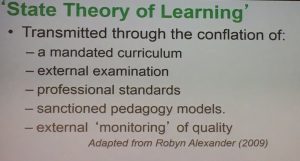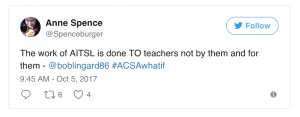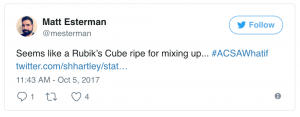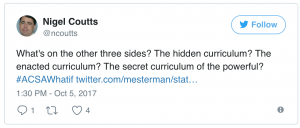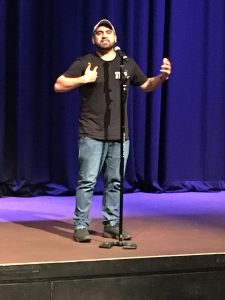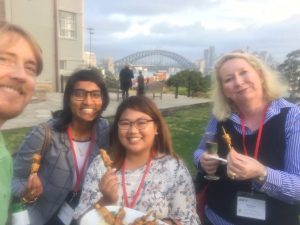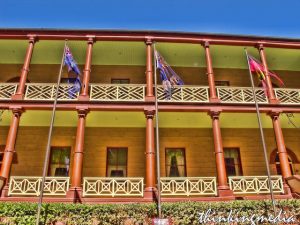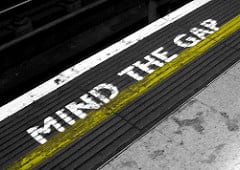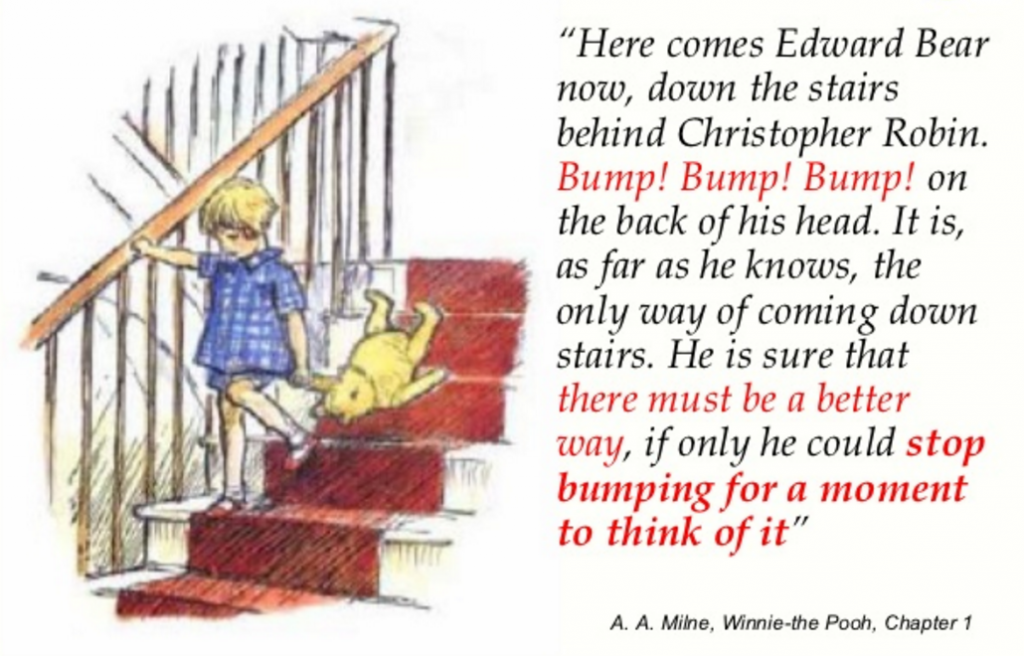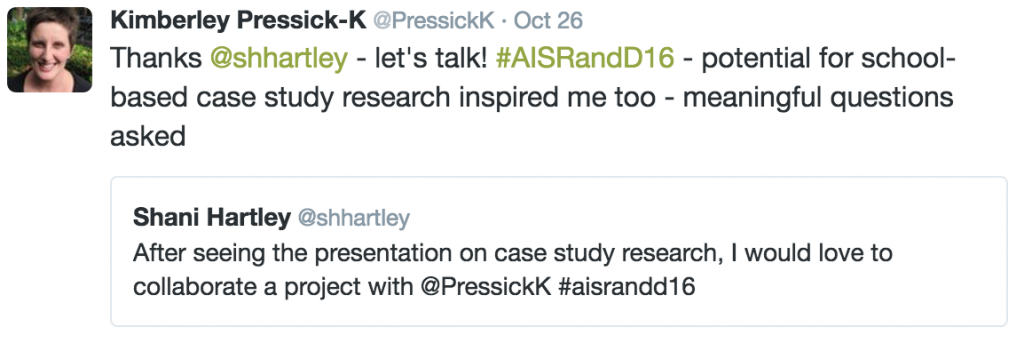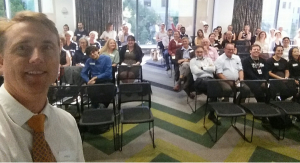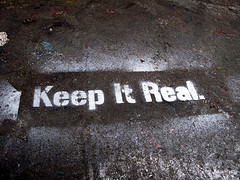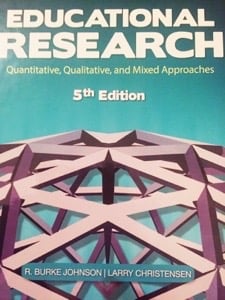2017 ACSA Conference
WHAT IF? Embracing complexity through curriculum innovation
Program: https://www.acsaconference.acsa.edu.au/program
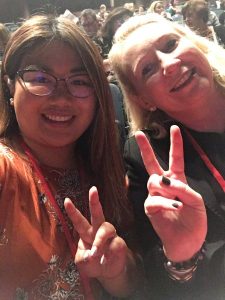
Day 2 @stephygsalazar & @shhartley
Part 2
“Education is not the filling of a pail, but the lighting of a fire”, W.B. Yeats
I ended the previous post with the plea that surely, learning is the point of education (as opposed to the final mark at the end). So let’s dig deeper into what learning entails, putting aside, for now, marks driven education.
The Purpose of Curriculum
One of the questions raised at the conference was regarding the purpose of education. According to Matthews (2013) Education is fundamentally concerned with the transmission of culture, values, beliefs, knowledge and skills (p.167).
I object to the use of the word transmission since it implies students are mere sponges. Is our curriculum meant to instil a particular set of culture, values, beliefs, knowledge and skills? And whose culture, values and beliefs are we talking about? Global or Australian? Should education be about the construction of culture, values, beliefs, knowledge and skills? You will often hear me being anti-dichotomies, espousing that education is about balance. Of course there are fundamentals to what young people should know and understand but it is also important that they learn to think for themselves.
In his Garth Boomer Memorial Lecture at the conference, Bob Lingard argued that globalisation has reduced national control over the economy and in response, governments are grabbing onto cultural sovereignty. He referenced on his slide:
Appadurai (2006) – two major tropes of neo-liberal globalisation: ‘loss of economic sovereignty’ (human capital framing) and attempted reassertion of cultural sovereignty (Australian Curriculum and citizenship focus)
This is seen in attitudes towards asylum seekers but also in rhetoric about education and how Australia performs in the global sphere and the citizens our education system is supposed to produce. There is a definite top-down approach to what values should be taught, demonstrated most clearly in the Values for Australian Schooling posters distributed to schools in February 2005.

The use of Simpson and his donkey in this poster is particularly contentious for me because there is much more to the story of Simpson than the heroic attributes assigned him in the context of the Anzac Legend construct. National curriculum reflects what is deemed important by those setting it. Perhaps also the global assessments of PISA, and to a lesser extent, TIMSS, is driving our content-heavy curriculum.
The Role of Teachers
In his workshop, Dr Phil Roberts talked about the ‘State Theory of Learning’ (see slide above). In this state-controlled content driven curriculum, teachers often feel stymied. Many teachers feel disenfranchised from the curriculum and believe they just need to do what they’re told, that they can’t be an integral part of forming curriculum. Some teachers feel so down-driven, time poor, they’re only covering superficial content not looking at the big picture of learning. Phil wondered how much of this has stemmed from an ‘outcomes’ approach to teaching by shifting the concept and focus of curriculum from being a holistic course to end results. He also proposed that it is time to start reclaiming the notion of teacher as curriculum worker, citing Nicole Mockler in her piece from earlier this year, Roll back curriculum constraints and give teachers the freedom to make professional judgements. For further reading, read Phil’s views on curriculum and Gonski in his 2013 article for The Conversation.
Bob Lingard pointed out that on top of the curriculum, teachers are further downtrodden with teacher standards under the quality teaching framework used to bash teachers for their shortcomings.
Instead teachers need to be respected for their expertise and given a stronger voice in policy.
Bob also wondered how much the ever-expanding high-stakes testing regime would become increasingly commercialised through the outsourcing of tests, curriculum, support materials and tutoring agencies. Thus, reducing teacher input to the construction of education even further.
General Capabilities
I must admit I’ve been a fan of Alan Reid’s approach to curriculum for a few years now. For my major assignment in Curriculum Studies (MEd), Collaborating and connecting: Making capabilities the core of curriculum, this was obvious. Just in case you don’t want to read all 2500 words, here is an excerpt and some direct quotes from the man himself:
Before the Australian curriculum was written, Professor Alan Reid (2005) wrote a comprehensive report which included compelling arguments for a “capabilities-based approach” (p.6) that “would take the emphasis off the subjects” (p.8). One argument involves that capabilities lie upon a never-ending scale of attainment whereas knowledge is more of a binary concept, either the facts are known or they are not (Reid 2005, p.54). It therefore goes part way to meeting the Melbourne Declaration goal of equity by allowing students to strive to the extent of their capabilities instead of judging them on how successfully they have acquired the prescribed knowledge. (Hartley 2013)
A central purpose of curriculum should be the development of capabilities for living in a democratic society… (Reid 2005, p.38)
…if the purpose of education is to promote human development through experience, then the starting point for curriculum work should be the identification of the capabilities that people need, individually and collectively, to live productive and enriching lives in the 21st century. (Reid 2005, p.53)
An official curriculum should reflect the kind of society we are and want to become, and should seek to develop the sorts of capabilities that young people need to become active participants in our political, economic, social and cultural life. (Reid 2010, p.31)
Earlier this year at an ACEL event, the NSW Minister of Education, Rob Stokes, said the purpose of education, based on Greek philosophy, was to prepare children to make a living and make a life. He acknowledged the social aspect of this as being almost impossible to measure. Is this difficulty in measurement behind the tick-box approach of the implementation of the general capabilities in many of our schools?
If schools are not being judged on the general capabilities of their students there is a lack of impetus to dedicate precious time to doing it properly. Instead, programs come under Learning Areas first, with the General Capabilities tenuously linked with existing material or superficially slotted-in where there are gaps.

The Real World

This cartoon was part of Bob Lingard’s slideshow.
The real needs of learners for the jobs and the global society of today and into the future was beautifully presented by Jan Owen, CEO of the Foundation for Young Australians. She described education as an ecosystem with complex, disparate, yet symbiotic elements. The research FYA has conducted illustrates a gig economy world that has disrupted the workplace. Our students are expected to have 17 jobs in a non-linear jungle of career progression. The jobs of the future are broken into seven clusters where the skills in one job are for the most part easily transferable to other jobs within the cluster.
The student panel conducted after Jan’s talk expressed excitement over the proposition that they can create their future, not merely accept it. The panel, however, also showed that to a great extent the students are a product of their school. The student from a prestigious private school preferred the linear progression of textbook learning and the straight-forwardness of exams. He also argued social justice education should be left to primary school so academics could be more thoroughly covered in high school. The other two liked being engaged in meaningful learning, including social justice, throughout their school life.
The wonderful Omar Musa performed several of his powerful poems about identity and place in Australia. He spoke of an Australia often unacknowledged by those in power. All aspects of Australian society should not only be acknowledged but be an integral part of our curriculum. In response to questions from the audience, he argued for relevance in education, that there is a need to attract students to the beauty and power of words through hip-hop music and the like. Of course, as someone in the audience pointed out, there are risks involved with teachers treading in unfamiliar territory, such as misogynist lyrics. Let’s leave that quandary there. Omar also presented a good case for teachers to focus on the talents of individuals, to recognise sparks in students and ignite them, like a teacher encouraged him to develop his use of words by expanding his range of reading matter. He also warned against teachers killing off free-thinking in their students, for example, a teacher berated him for reading Trainspotting and damned his parents. for allowing him to do so. I am grateful this teacher failed to curb Omar’s enthusiasm for words. For more Omar Musa, see his website and Ted Talk.
Our world is so much more complex than our curriculum makes it appear. We therefore need to address contentious issues in schools. As Prime Minister, Julia Gillard wanted to focus on human rights within our schools, so in response UTS (Burridge et al, 2013) investigated “the place of human rights education in the school curriculum in each state and territory and the extent of the opportunities for teaching and learning about human rights across the school years” (p.5) in a report called Human Rights Education in the School Curriculum. This report was co-authored by Nina Burridge, who was asking at the conference, how far teachers can go as activists within schools. Teachers generally feel they are meant to be politically neutral in class, but when human rights, social justice and viewpoints of history are involved (for example), it is basically impossible to be neutral. I believe teachers have a responsibility to address a variety of global and local issues. However, parents and politicians complain about teachers indoctrinating students, forgetting young people have minds of their own and their right to make their own (informed) decisions. It seems there is a fine line between this responsibility and being considered irresponsible radical activists. Yet again, teachers’ professionalism is called into question.
The next post, the last in the trilogy, will:
- Address how schools and teachers can reclaim some aspects of the curriculum, partly through changing their pedagogical practices
- Cover the TeachMeet held during the conference
- Present other parts of the conference that haven’t neatly fitted into what I’ve written elsewhere
References
Matthews, J. (2013). The educational imagination and the sociology of education in Australia. Australian Educational Researcher, 40, 155-171.
Reid, A. (2005). Rethinking National Curriculum Collaboration: Towards an Australian Curriculum, Department of Education, Science and Training, Canberra.
Reid, A. (2010). Working towards a ‘world-class’ curriculum. Professional Educator, 9(2), 30-33. Retrieved from http://search.informit.com.au.simsrad.net.ocs.mq.edu.au/
